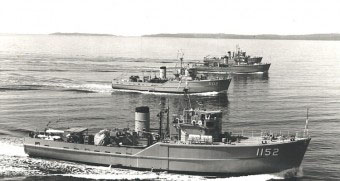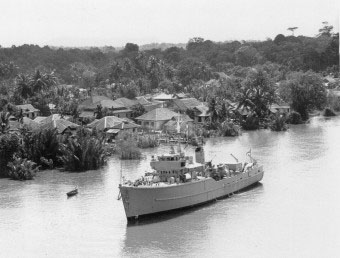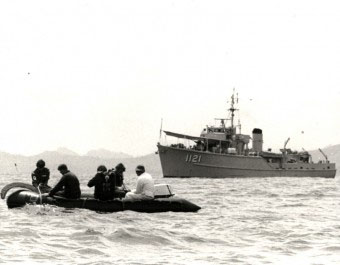December 2012 marked the 50th anniversary of the arrival of the six Ton Class minesweepers of the 16th Minesweeper Squadron in Sydney and the commissioning of their base as HMAS Waterhen.Their arrival in Australia represented a significant improvement in the capabilities in the mine warfare field of the Royal Australian Navy. The RAN had swept mines during World War I and World War II and had cleared defensive minefields in the Barrier Reef in 1946-47. However, the retirement of most of the Bathurst Class corvettes, of which HMAS Castlemaine moored at Williamstown is one of the few survivors, had seen the RAN’s capabilities for sweeping mines dramatically decline.

Mines re-entered the naval picture in a big way during the Korean War when they were laid by the North Korean People’s Army from sampans and other small craft in the shallow waters of west coast of the Korean Peninsula and set as drifting mines in the deep water off the east coast. These caused serious damage and casualties, and one US Navy Admiral observed as a planned amphibious landing was abandoned in the face of a mine threat; ’We have lost control of the sea to a nation without a navy using pre-World War 1 weapons laid by vessels that were utilised at the time of the birth of Christ’.
This re-demonstration of the utility of the sea mine in littoral waters caused some rethinking in Allied naval circles which spawned a huge program of building mine countermeasure vessels to a common design by most NATO countries. It was from this stock that the RAN selected its ships: most had been used by the Royal Navy’s reserve port divisions for training, and several had had different names in the period after their launching in the early 50s. Before commissioning into the RAN they underwent considerable modernisation including the re-engineering of the ships with the powerful Napier Deltic engines used to drive railway locomotives, improvements to their armament and sensors and the reconfiguration of two of the ships as minehunters. The RAN gave the ships bird names on commissioning in August 1962 – Curlew, Gull, Hawk, Ibis, Snipe and Teal.
These were tough little ships displacing 480 tons at full load, 47 m long with a beam of 9 m and a draft of only 2.5 m. Constructed of timber on an aluminium frame the superstructure was also aluminium. The use of magnetic metals was strictly controlled to reduce the ships’ magnetic signature, and to counter the acoustic mine their machinery was mounted on a raft supported by resilient bearings to reduce noise transfer into the water. Speaking of noise, the engine rooms were so noisy that the Ton Class were arguably the first ships in the RAN to have machinery control rooms where the watchkeeper could monitor and control the machinery in relative comfort. Engine changes were facilitated by the construction of these ships, as the whole after superstructure lifted off revealing the engine room below. The old engine was hoisted out, the new one hoisted in and the superstructure re-attached to the upper deck. A good team could get the whole machinery changed round in about six hours.
As minesweepers, the Ton Class carried a complement of 38 men in reasonable comfort. They were air-conditioned for tropical service, and they cruised economically at 12 1/2 knots. Top speed was 15 1/2 knots – ‘down sea and with a following wind’. Somewhat lively in a head sea, they were also fitted with stabilising fins port and starboard (an RAN first), not for crew comfort but to dampen any rolling movement which would induce eddy currents detectable by magnetic mines.
They mounted a single Bofors mounting forward (expanded to two Bofors and assorted light weaponry during Confrontation), but their ‘main armament’ was their mine countermeasures suite. They carried the conventional mechanical wire sweeps for use against moored mines, as well as buoyant electrodes towed astern of the ship through which a pulsed electric current was passed from a special diesel generator to deal with magnetic mines. Amongst the more unusual equipment were an acoustic ‘hammer’ sweep which transmitted a tremendous volume of noise into the water against acoustic mines, and a mechanism which discharged a graduated series of explosive charges from the side of the ship to create a pressure wave against the so-called ‘oyster’ mines. The two minehunters eventually received their mine hunting sonars and the displays and other equipment necessary for their operations in this role, including divers, in Australia.

The opportunity of the passage from the UK to Australia was used by the RAN to provide practical training in mine warfare to regular and reserve personnel. Each ship carried a few reserve officers and sailors, as well as the newly-minted class of Australian Acting Sub-Lieutenant graduates from Britannia Royal Naval College, Dartmouth. Following their commissioning and trials, the Squadron worked out of the Firth of Forth learning the art and skills of mine warfare at HMS Lochinvar. Then on 1 October 1962 they sailed from Portsmouth in company with HMAS Supply, also on her delivery voyage to Australia as an RAN ship. The passage took the ships to Gibraltar, Malta, through the Suez Canal, to Aden, Colombo, Singapore, Darwin and finally to Sydney, arriving 7 December at Waterhen, which had commissioned the day before. The voyage had some excitement especially for Curlew, which spent almost the entire time on one engine because of the collapse of one of her resilient mountings under the machinery raft.
The capabilities of the new ships in their minesweeping role were tested the following year when they undertook Operation GARDENING, sweeping for US influence mines which had been dropped during World War II in Tonelei Harbour near Buin in Bougainville, and conducting a check sweep of Cheshunt Bay to the east of Port Moresby. However, 1964 saw a major change in employment of the ships, with the dispatch of two – Gull and Hawk – to join the British Far East Fleet in Singapore to counter Indonesia’s ‘Confrontation’ of Malaysia. All six Ton Class participated in operations to patrol Malaysia waters and to intercept infiltration craft attempting to cross the Malacca and Singapore Straits. HMAS Teal was especially successful, frustrating several Indonesian infiltration attempts at capturing a large number of prisoners. Her commanding officer Lieutenant Commander Gus Murray was awarded the Distinguished Service Cross as a result of his actions, the only decoration made to the RAN in this entire campaign.
Although much slower than the craft they were trying to deter and relatively noisy, the Ton Class minesweepers of the Royal, Australian and New Zealand navies were assessed to have intercepted or prevented more than 80% of the attempted assaults on Malaysia and Singapore across the Straits from Indonesia. Just as their predecessors in the Bathurst Class had done, they had shown themselves to be maids of all work, rugged, flexible and dependable.
However, maintenance costs and personnel shortages caused the decommissioning of several of the ships –Snipe in December 1966, Hawk and Gull in May 1967 and Ibis and Teal in January 1968, but not before Ibis and Teal had conducted a series of surveys and exercises which saw them circumnavigate the continent in late 1967. It was the first of several for Ibis. In December 1966 Curlew was taken in hand for conversion into the RAN’s first minehunter with the sonar fitted, removal of influence sweeps, and the fitting of active rudders for slow speed manoeuvring and a one-man decompression chamber. A Clearance Diver component now joined her complement, reduced to 31. She recommissioned in December 1968.

Minehunting involves the identification of suspicious objects under or at the bottom of the sea by sonar and their investigation, at first using divers and latterly using remotely operated vehicles equipped with CCTV. The advantages are that effort is applied to identified objects rather than the expenditure of time and effort on sweeping areas where mines are only suspected to have been laid. It is also safer for the mine warfare vessel, which does not have to expose herself to a mine strike while sweeping a field.
In July 1968 the recommissioned Gull, Hawk and Snipe were deployed to Southeast Asia for exercises with allied navies, and later that year they carried out another minesweeping operation in PNG. Snipe then paid off for conversion to minehunting, recommissioning in February 1971. The other two, with Curlew in company, were back in Southeast Asia again in 1969 for exercises. Their passage south-about had included survey operations off Anglesea in Victoria. On their return they conducted a national mapping survey in the Coral Sea. But this was the end of the line for Gull. She was paid off into reserve in November and was stripped for spares before being sold in January 1976.
Hawk was also paid off but recommissioned the following September. As a consequence of the introduction of minehunting in the RAN the need arose to identify what objects were already on the sea bottom – a mine warfare pilot survey – of the approaches to ports and major inshore sea lanes. With Curlew and Snipe, Hawk conducted a survey up the east coast from May 1971, which included a visit to PNG and the provision of aid to the PNG Government in Rabaul following an earthquake. But she paid off for the final time in January 1972 and was sold for scrap in 1976.
Meanwhile, a recommissioned Teal briefly re-joined the squadron for a Southeast Asian deployment in mid-1970, but was back in reserve in August. Recommissioned in January 1972 she deployed again to her old stamping grounds in Southeast Asia with Curlew and Snipe for exercises, enlivened by the search for a crashed Malaysian fighter off Penang and the sweeping of a WWII minefield near Port Moresby, but Teal’s naval service was now at an end. Paid off into reserve, she was sold in 1977 and converted into a fishing trawler.
That left three of the six ships still in service. The next five years saw them variously engaged in exercises, in mine warfare pilot survey work, and on oceanographic work during which Curlew and Ibis again circumnavigated Australia in 1977. They deployed once again to Papua New Guinea in 1975 to sweep influence mines laid in World War II in Port Moresby ahead of the laying of a submarine cable. This was followed by surveys in the approaches to Darwin searching for wreckage arising from Cyclone Tracy, which destroyed the city at Christmas 1974. They located several sunken trawlers and other navigational hazards. In 1978 Curlew assisted in the recovery of the Royal Australian Air Force F-111 which had crashed into the sea off New Zealand. That same year she had apprehended a Japanese fishing vessel operating in Australian waters.
In 1980, the ships visited Tasmania for the Hobart Regatta and carried out a team sweep in northern Tasmanian waters which, at 90 nautical miles and 40 hours, was the longest since World War II and a record for the RAN Ton Class. This was followed by a deployment to the Southwest Pacific and the following year Curlew and Ibis took part in the first mine countermeasures exercise between the RAN and the Indonesian Navy. In 1982 Ibis reverted to her Confrontation role of offshore patrol by participating in the Bass Strait oil platform surveillance operation, Operation ESTES.
In June 1983, Snipe was decommissioned as her hull had deteriorated to an unacceptable state, leaving Curlew as the oldest serving ship the RAN with 21 years to her credit. Ibis followed in May 1984 and in that year Curlew made her final overseas deployment. She spent the remaining six years of her life working with the new inshore minehunters and trialling new mine countermeasures equipment. In February 1989, she became the training ship for the mine countermeasures category personnel at HMAS Waterhen. But the tough old ship decommissioned on 30 April 1990. She had steamed more than 400,000 miles in 40,000 hours underway, and she paid off exactly 38 years from the laying of her keel in the UK.
Thus ended the story of the Ton Class, rugged and versatile little ships which served Australia proudly and well in war and peace. They contributed to the training of the men and women of the Royal Australian Navy in seamanship in testing conditions, as well as working with the ships of many other allied and friendly navies on exercises and operations. Perhaps their lasting contribution was the mine warfare pilot survey, which remains as the basis for Australian mine countermeasures. They are not often recalled today except, perhaps, by those had the pleasure and privilege to serve in them but the hard work they put in, while less glamorous than that of some other ships, should be remembered with affection, and respect.
Ian Pfennigwerth
(Commissioning crew, HMAS Curlew)
Contact Ian Pfennigwerth about this article.






